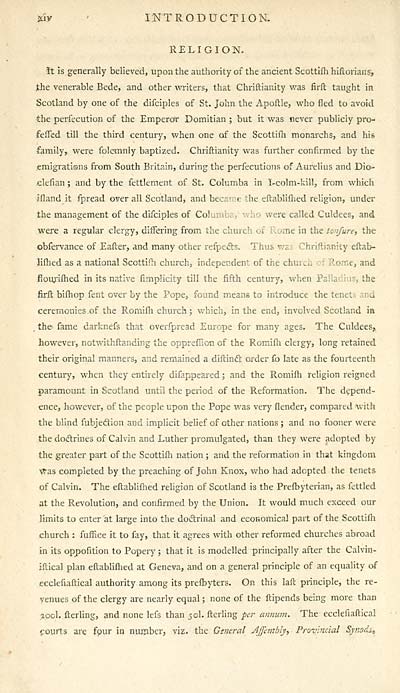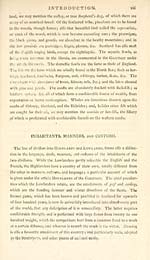Gazetteer of Scotland
(22) Page xiv
Download files
Complete book:
Individual page:
Thumbnail gallery: Grid view | List view

%ly INTRODUCTION*
RELIGION.
It is generally believed, upon the authority of the ancient Scottifh hiftorians,
jthe venerable Bede, and other writers, that Chriftianity was firft taught in
Scotland by one of the difciples of St. John the Apoftle, who fled to avoid
the perfecution of the Emperor Domitian ; but it was never publicly pre-
ferred till the third century, when one of the Scottifh monarchs, and his
family, were folemnly baptized. Chriftianity was further confirmed by the
emigrations from South Britain, during the perfecutions of Aurelius and Dio-
clefian ; and by the fettlement of St. Columba in I-colm-kill, from which
ifland it fpread over all Scotland, and became the eftablifhed religion, under
the management of the difciples of Columba, who were called Culdees, and
were a regular clergy, differing from the church of Rome in the tonfure, the
obfervance of Eafter, and many other refpects. Thus we; Chriftianity eftab-
lifhed as a national Scottifh church, independent of the chuich of Rome, and
fiouxifhed in its native ftmplicity till the fifth century, when Palladius, the
firft bifhop fent over by the Pope, found mean6 to introduce the teneti and
ceremonies of the Romifh church ; which, in the end, involved Scotland in
, the fame darknefs that overfpread Europe for many ages. The CuldeeS;,
however, notwithftanding the oppreffion of the Romifh clergy, long retained
their original manners, and remained a diftincl; order fo late as the fourteenth
century, when they entirely difappe'ared ; and the Romifh religion reigned
paramount in Scotland until the period of the Reformation. The depend-
ence, however, of the people upon the Pope was very [lender, compared 'with
the blind fubjection and implicit belief of other nations ; and no fooner were
the doctrines of Calvin and Luther promulgated, than they were adopted by
the greater part of the Scottifh nation ; and the reformation in that kingdom
was completed by the preaching of John Knox, who had adopted the tenets
of Calvin. The eftablifhed religion of Scotland is the Prefbyterian, as fettled
at the Revolution, and confirmed by the Union. It would much exceed our
limits to enter at large into the doctrinal and economical part of the Scottifh
church : fuffice it to fay, that it agrees with other reformed churches abroad
in its oppofition to Popery ; that it is modelled principally after the Calvin-
iftical plan eftablifhed at Geneva, and on a general principle of an equality of
ecclefiaftical authority among its prefbyters. On this laft principle, the re-
venues of the clergy are nearly equal ; none of the ftipends being more than
aool. fterling, and none lefs than 50I. fterling per annum. The ecclefiaftical
courts are fpur in number, viz. the General JJembly, Provincial Synods
RELIGION.
It is generally believed, upon the authority of the ancient Scottifh hiftorians,
jthe venerable Bede, and other writers, that Chriftianity was firft taught in
Scotland by one of the difciples of St. John the Apoftle, who fled to avoid
the perfecution of the Emperor Domitian ; but it was never publicly pre-
ferred till the third century, when one of the Scottifh monarchs, and his
family, were folemnly baptized. Chriftianity was further confirmed by the
emigrations from South Britain, during the perfecutions of Aurelius and Dio-
clefian ; and by the fettlement of St. Columba in I-colm-kill, from which
ifland it fpread over all Scotland, and became the eftablifhed religion, under
the management of the difciples of Columba, who were called Culdees, and
were a regular clergy, differing from the church of Rome in the tonfure, the
obfervance of Eafter, and many other refpects. Thus we; Chriftianity eftab-
lifhed as a national Scottifh church, independent of the chuich of Rome, and
fiouxifhed in its native ftmplicity till the fifth century, when Palladius, the
firft bifhop fent over by the Pope, found mean6 to introduce the teneti and
ceremonies of the Romifh church ; which, in the end, involved Scotland in
, the fame darknefs that overfpread Europe for many ages. The CuldeeS;,
however, notwithftanding the oppreffion of the Romifh clergy, long retained
their original manners, and remained a diftincl; order fo late as the fourteenth
century, when they entirely difappe'ared ; and the Romifh religion reigned
paramount in Scotland until the period of the Reformation. The depend-
ence, however, of the people upon the Pope was very [lender, compared 'with
the blind fubjection and implicit belief of other nations ; and no fooner were
the doctrines of Calvin and Luther promulgated, than they were adopted by
the greater part of the Scottifh nation ; and the reformation in that kingdom
was completed by the preaching of John Knox, who had adopted the tenets
of Calvin. The eftablifhed religion of Scotland is the Prefbyterian, as fettled
at the Revolution, and confirmed by the Union. It would much exceed our
limits to enter at large into the doctrinal and economical part of the Scottifh
church : fuffice it to fay, that it agrees with other reformed churches abroad
in its oppofition to Popery ; that it is modelled principally after the Calvin-
iftical plan eftablifhed at Geneva, and on a general principle of an equality of
ecclefiaftical authority among its prefbyters. On this laft principle, the re-
venues of the clergy are nearly equal ; none of the ftipends being more than
aool. fterling, and none lefs than 50I. fterling per annum. The ecclefiaftical
courts are fpur in number, viz. the General JJembly, Provincial Synods
Set display mode to: Large image | Transcription
Images and transcriptions on this page, including medium image downloads, may be used under the Creative Commons Attribution 4.0 International Licence unless otherwise stated. ![]()
| Gazetteers of Scotland, 1803-1901 > Gazetteer of Scotland > (22) Page xiv |
|---|
| Permanent URL | https://digital.nls.uk/97343692 |
|---|

